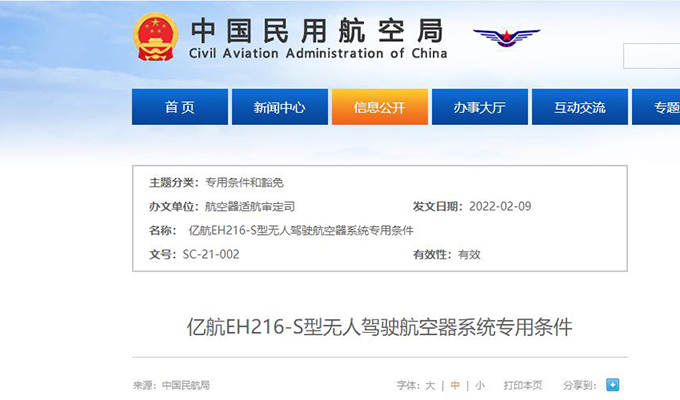Guangzhou, China, February 23, 2022 -- EHang Holdings Limited (Nasdaq: EH) (“EHang” or the “Company”), the world's leading autonomous aerial vehicle (“AAV”) technology platform company, today announced that the Civil Aviation Administration of China (“CAAC”) has formally adopted the Special Conditions for EH216-S AAV Type Certification (the “Special Conditions”), which was effective on February 9th, 2022 and published on the CAAC website on February 22th, 2022.
The Special Conditions provides EHang with the basis for compliance and safety of EH216-S AAVs, including flight performance, structures, design and constructions, propulsion systems, systems and equipment, data link and ground control station. The Company expects to deploy the EH216-S unmanned aircraft system in low-altitude passenger-carrying commercial operations in the Urban Air Mobility sector.

*The EH216-S refers to the standard model for passenger transport in the EH216 series, compared to the EH216F model for firefighting and the EH216L model for aerial logistics.
About EHang
EHang (Nasdaq: EH) is the world's leading autonomous aerial vehicle (AAV) technology platform company. Our mission is to make safe, autonomous, and eco-friendly air mobility accessible to everyone. EHang provides customers in various industries with AAV products and commercial solutions: air mobility (including passenger transportation and logistics), smart city management, and aerial media solutions. As the forerunner of cutting-edge AAV technologies and commercial solutions in the global Urban Air Mobility (UAM) industry, EHang continues to explore the boundaries of the sky to make flying technologies benefit our life in smart cities. For more information, please visit www.ehang.com.
Safe Harbor Statement
This press release contains statements that may constitute “forward-looking” statements pursuant to the “safe harbor” provisions of the U.S. Private Securities Litigation Reform Act of 1995. These forward-looking statements can be identified by terminology such as “will,” “expects,” “anticipates,” “aims,” “future,” “intends,” “plans,” “believes,” “estimates,” “likely to” and similar statements. Management has based these forward-looking statements on its current expectations, assumptions, estimates and projections. While they believe these expectations, assumptions, estimates and projections are reasonable, such forward-looking statements are only predictions and involve known and unknown risks and uncertainties, many of which are beyond management's control. These statements involve risks and uncertainties that may cause EHang's actual results, performance or achievements to differ materially from any future results, performance or achievements expressed or implied by these forward-looking statements.